Recent News
Aquarium Hall Closing For Roof Upgrade WorkMonday, September 08, 2014
The Aquarium Hall will close on October 5, 2014 in order to allow for roof replacement work to take place, though the North Rock Exhibit, as well as the Zoo, Museum, Azu Beastro, and the Bermuda Zoological Society [BZS] Gift Shop will remain open.
Scholarships for environmental studies trio
Friday, September 05, 2014
Three young Bermudians have been awarded $5,000 each to help them continue their studies.
Steinhoff/BZS Scholarship Winners Announced
Thursday, September 04, 2014
The Bermuda Zoological Society announced the winners of the 2014 Steinhoff/BZS Scholarship as students Miguel Meijas, Kate Cooper, and Kascia White. Each student has been award $5,000 towards their continued studies in the environmental sciences.
Aquarium ceiling collapses — no injuries
Wednesday, August 20, 2014
A ceiling at the Bermuda Aquarium, Museum and Zoo fell in yesterday due to recent heavy rain.
Part Of Internal Ceiling Collapses At Aquarium
Tuesday, August 19, 2014
The Department of Conservation Services confirmed that today [Aug 19] a small area of the internal ceiling collapsed in the Aquarium Hall at the Bermuda Aquarium Museum and Zoo [BAMZ].
About
GovernanceAbout Us
Newsletter
Latest News
Gift & Bookstore
Contact
General Inquiries
info@bzs.bm
Latest News
All the latest updates and news from the Bermuda Aquarium, Museum, and Zoo, one of Bermuda's leading visitor attractions!
Excerpt from WILD News May 2018

This is Sheldon, a juvenile loggerhead turtle. Between December and March juvenile sea turtles (loggerheads, hawksbills and green sea turtles) will be swept up past Bermuda as they drift with their transient home of Sargassum. Sargassum is brown algae found in the Atlantic Ocean that forms dense floating masses called rafts which provide shelter, transport and food for many organisms. During this stage of their life (post hatchling), turtles are carried around with the currents. The Sargassum provides food such shrimp, tiny crabs and fish. Sea turtles eat whatever floats by and this often gets them into trouble. The Sargasso Sea is located in the North Atlantic Gyre and collects lots of microplastics. Sea turtles are not picky eaters and may eat the plastics This can cause an impaction of their digestive tract which can be life-threatening.


As they pass by Bermuda, they may be washed ashore by a winter storm or get picked up by birds that later drop them. As a result, these little critters can end up on one of our beaches or dropped amongst the rocks. The Wildlife Rehabilitation Department at BAMZ sees one or two post hatchling sea turtles a year. These post hatchlings are three to four inches in length and tend to be thin and exhausted from their journey. Because of their tiny size, they may have sustained injuries from predator attacks. We monitor them and give them time to rest and regain strength. Any injuries are treated and an appropriate amount of time is given to heal. We wait until the water warms up and we see large rafts of Sargassum returning offshore (May or June) before releasing them. By this time they have grown six to eight inches long. The release is done offshore so they can pick up the currents under a Sargassum raft and continue on their ocean journey. They will return to Bermuda again in 3-4 years as they move from their pelagic lifestyle to the reef shelf.

The current juvenile loggerhead was found on the beach at Willowbank on March 30, 2018. It appears healthy and is gaining weight. We hope to get it back out to the big blue in the near future. Note the tank it is currently in is actually the perfect spot for it at the moment. It would normally be in the open ocean all day in a vast sea of blue, and only given shelter by a Sargassum raft. The blue background is exactly what it would be seeing in the wild. Also, we can't tell the sex of the turtle at this age without a blood sample, so the sex remains unknown.



